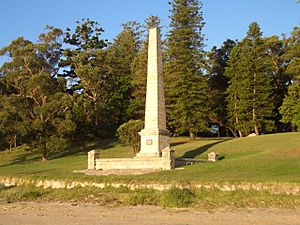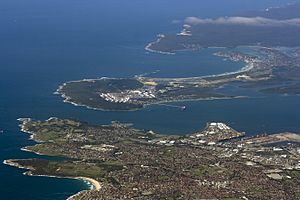Kurnell, New South Wales facts for kids
Quick facts for kids KurnellSydney, New South Wales |
|||||||||||||||
|---|---|---|---|---|---|---|---|---|---|---|---|---|---|---|---|
| Population | 2,267 (2016 census) | ||||||||||||||
| Postcode(s) | 2231 | ||||||||||||||
| Elevation | 19 m (62 ft) | ||||||||||||||
| Location | 22 km (14 mi) S of Sydney CBD | ||||||||||||||
| LGA(s) | Sutherland Shire | ||||||||||||||
| State electorate(s) | Cronulla | ||||||||||||||
| Federal Division(s) | Cook | ||||||||||||||
|
|||||||||||||||
Kurnell is a suburb located in Sydney, New South Wales, Australia. It is about 21.4 kilometers south of the main city center. Kurnell is part of the Sutherland Shire local government area. It sits along the east coast of Australia.
The only suburbs right next to Kurnell are Cronulla and Woolooware. Across Botany Bay to the north, you can see La Perouse. The famous Cronulla sand dunes are also nearby. Part of the Kamay Botany Bay National Park is on the eastern side of the peninsula. The Towra Point Nature Reserve is on the western side.
Contents
Kurnell's Interesting History
Kurnell is a very important place in Australian history. It is where Captain James Cook first landed on 29 April 1770. This was the first time Europeans made contact with the Gweagal Aboriginal people in this area. Cook was exploring the East Coast of Australia on his ship, the Endeavour.
Captain Cook's Visit
Captain Cook and his crew stayed in Kurnell for eight days. During this time, they collected plants and mapped the area. They also tried to meet the local Aboriginal people, but they were not successful. When Cook reported back to England, he said the land was good for farming. He also noted it had many trees.
The First Fleet Arrives
Later, on 18 January 1788, Captain Arthur Phillip arrived in his ship, H.M. Armed Tender Supply. He came before the main First Fleet arrived. Phillip followed Cook's advice and started clearing land and digging wells. This was near what is now La Perouse. However, after a week, Phillip decided to move. He took the fleet north to Port Jackson, which is now Sydney Cove.
Important Memorials
Cook's landing spot is in the northern part of the national park. Sutherland Point is named after Forby Sutherland. He was a crew member who sadly died during their eight-day stay. He was buried on the shore. Cape Solander is named after Daniel Solander, a Swedish botanist. He worked with Joseph Banks. Inscription Point got its name in 1822. A plaque was placed there to mark where the Endeavour's crew first landed.
Some streets in Kurnell are named after other famous explorers. These include Dampier Street, Tasman Street, and Torres Street.
Early Farms and Fishing
The first large piece of land, about 700 acres, was given out in 1815. It went to Captain James Birnie, who started Alpha Farm. 'Alpha' means the first letter in the Greek alphabet. This name was chosen because it was the first farm in the area. In 1821, John Connell Junior also received land. He used it for cutting timber. His father bought Alpha Farm from Birnie. By 1842, the Connell family owned over one thousand acres.
In 1860, Thomas Holt bought Alpha Farm. He owned most of the land from Sutherland to Cronulla. For a while, the area was called Birniemere. Holtmere was also once a local name.
Before the 1920s, Kurnell was a popular spot for fishermen. Many types of fish lived in Botany Bay and the open sea. Fishermen built small huts and shacks to stay in for weekend fishing trips. During the Great Depression in the late 1920s, many families with low incomes moved there. They built a shantytown, which was a collection of makeshift homes.
The Big Storm of 2015
On 16 December 2015, a powerful tornado hit the New South Wales coast. It brought heavy rain, large hailstones, and very strong winds. Kurnell was hit especially hard around 10:30 am. Homes and businesses lost their roofs. Electricity and sewerage services were cut off. Two trucks were even blown onto their sides.
Workers had to leave the Kurnell Refinery and the desalination plant, which was damaged. A wind gust of 213 km/h was recorded in Kurnell. This was the fastest wind speed ever recorded in New South Wales history! Luckily, only minor injuries were reported. The storm caused about AUD 206 million in damage to Kurnell. Other areas like Westfield Bondi Junction and Nowra also had roof damage. Thousands of homes lost power north of Wollongong.
Fun Things to See and Do in Kurnell
The northern part of the Kurnell peninsula is a historic site. It is known as Captain Cook's Landing Place. You can find several memorials here:
- Captain Cook Memorial Obelisk
- Sir Joseph Banks Memorial
- Solander Monument
- Sutherland Monument
The Discovery Centre offers information and shows items from Kurnell's early days. Endeavour Heights is a recreation area inside the Botany Bay National Park. From the Kurnell Lookout, you get amazing views of Botany Bay. You can also see the northern headland of Botany Bay at La Perouse.
Cape Solander is a great place to watch whales. Many people visit during the whale migration season.
Getting Around Kurnell
Transdev NSW operates a bus route in Kurnell. Bus route 987 goes from Kurnell to Cronulla, passing through North Cronulla.
Sports and Outdoor Fun
Kurnell is home to the Stingrays JRLFC, a local rugby league club. Greenhills Skatepark is in Kurnell on Captain Cook Drive. It has bowls and street sections for skaters.
Triathlons are held in Kurnell every year. You can find running tracks through Botany Bay National Park. You can also run along the beach. Swimming is safe in the netted area of Silver Beach. This spot is also great for fishing, sailing, scuba diving, and windsurfing. During whale watching season, a free shuttle bus runs from the National Park office parking area.
Boat Harbour Beach has a 4WD park. You can get there via Captain Cook Drive. People are allowed to drive their 4WDs on the beach. There is an entry fee, and you can drive along the beach for at least two kilometers.
Images for kids
-
Cliff and Pacific ocean view











